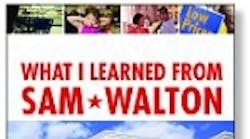Think Wal-Mart is just a retailer? Think again. Wal-Mart is a manufacturing, IT, logistics and distribution driven company that also has retail stores. In other words, it's a supply-chain driven company says Michael Bergdahl, a former Wal-Mart director who worked directly under Sam Walton. The influence of Sam Walton and the world's largest retailer cannot be underestimated says Bergdahl but companies can successfully compete against it.
In his new book, What I Learned From Sam Walton: How To Compete and Thrive in a Wal-Mart Word, Bergdahl lays out strategies on: pricing, operations, culture, key product, expenses, talent and service (POCKETS).
"Manufacturers need to realign their game plan. Customers are in charge and shelf space is not guaranteed. Private label products will happily move onto the shelf if yours isn't available," explains Bergdahl. This is true for many retailers, not just Wal-Mart, and is especially true in Europe where private label products make up 40% of the retail market.
That puts the supply chain front and central to a manufacturer's profitability. Wal-Mart has honed the hub-and-spoke distribution strategy which provides one of its key operational competitive advantages, explains Bergdahl. While Wal-Mart needs only 10% of its stores square footage for inventory, competitors need 25%. That's because each store is within a day's drive of a distribution center.
In the book, Bergdahl quotes Jay Fitzsimmons, a Wal-Mart senior vice president and treasurer as saying that "we're in the distribution business. It's Wal-Mart's job to bring a product from the dock to the customer's trunk in as little as 72 hours."
One way that Wal-Mart brings in products so quickly is their unique relationship with vendor partners. Other companies can replicate this model and in fact Bergdahl suggests that companies take advantage of professional trade associations to create teams of local companies. And use the organization as a platform to share best practices advises Bergdahl. That's what the largest companies do -- they benchmark best practices against each other. GE, P&G, FedEx, Home Depot all share ideas.
"Differentiating products is how manufacturers will succeed today," says Bergdahl. Companies must hold onto their brands for that is their true value in the marketplace. "Manufacturers have to realize that they are in the business of branding and not manufacturing as we thought of it in the past. In some cases that means managing the brand and outsourcing the actual manufacturing process."
Another area of success for Wal-Mart is its ability to control its expenses. "Wal-Mart has changed the traditional standards of expense control, evolving, or morphing them to a previously unheard-of level, disproving the notion that you can't save your way to prosperity," says Bergdahl.
Cost control at Wal-Mart's is sort of like an extreme sport says Bergdahl. He tells a story in the book about Lee Scott, current CEO of Wal-Mart, sharing a hotel room at Days Inn with the CFO to save money. To ward against excess spending in a company as large as Wal-Mart each employee acts as if they were responsible for paying the company's bills at the end of the month explains Bergdahl. The company's profit-sharing plan seems to be the driving force behind employee frugality.
Cost savings are huge in Wal-Mart's distribution and logistic functions as it employs a method called cross-docking. Products are received on one side of the warehouse and leave out of the other side, virtually eliminating the storage of goods. A form of just-in-time distribution, merchandise flows through the distribution center to the customer in the shortest time possible. Using company owned fleet and tractors Wal-Mart replenishes its own stores 24 hours per day from its own distribution centers. Using technology like RFID and VSAT systems (Very Small Aperture Terminal) velocity of products is greatly increased and inventory turns are quite high.
"The key to competing and surviving against Wal-Mart is to focus your business into a niche or pocket where you can leverage your strengths in the local marketplace," says Bergdahl. Using Sam Walton's own rules for building a business, companies can compete. Bergdahl summarized these rules:
- Commit to and communicate a clear business strategy.
- Take care of your people.
- Control costs.
- Take care of your customer
- It can if you use the POCKETS strategies.Take calculated risk to set your business apart.
Michael Bergdahl is a former director of Wal-Mart. He has also worked with Frito-Lay and American Eagle Outfitters. He has been involved with two successful business turnarounds. For information on his book and speaking schedule visit www.michaelbergdahl.net.




